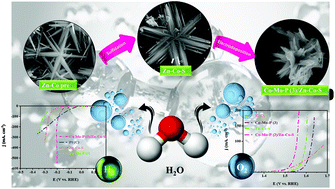Dual-electrocatalysis behavior of star-like zinc–cobalt-sulfide decorated with cobalt–molybdenum-phosphide in hydrogen and oxygen evolution reactions†
Abstract
Although important advances have been acquired in the field of electrocatalysis, the design and fabrication of highly efficient and stable non-noble earth-abundant metal catalysts for the oxygen evolution reaction (OER) and hydrogen evolution reaction (HER) remain a significant challenge. In this study, we have designed a superior bifunctional catalyst for OER and HER in alkaline media based on the Co–Mo–P/Zn–Co–S multicomponent heterostructure. The as-prepared multicomponent heterostructure was successfully obtained via a simple three-step hydrothermal–sulfidation–electrodeposition process consisting of star-like Co–Zn–S covered with Co–Mo–P. The structure and morphology evaluation of the prepared catalysts were performed via Fourier transform infrared spectroscopy, X-ray diffraction spectroscopy, field emission scanning electron microscopy, X-ray photoelectron spectroscopy, energy-dispersive X-ray spectroscopy, and elemental mapping techniques. The electrochemical tests show that Co–Mo–P/Co–Zn–S exhibits outstanding activity toward both OER and HER with OER overpotentials of 273 mV and 312 mV to drive the benchmark current densities of 10 and 50 mA cm−2, respectively, with a Tafel slope of 41 mV dec−1. In addition, the HER overpotentials of 120 mV and 165 mV were required to reach the benchmark current densities of 10 and 50 mA cm−2, respectively, with a Tafel slope of 61.7 mV dec−1 that outperforms most other state-of-the-art catalysts. In the case of HER, the prepared catalyst required an overpotential of 202 mV to reach the current density of 200 mA cm−2 that was much lower than the overpotential of Pt/C (286 mV) to achieve the same current density. Co–Mo–P/Co–Zn–S also exhibits a suitable stability length of 10 h for OER and HER during the chronoamperometric tests. The superior performance of the Co–Mo–P/Co–Zn–S multicomponent heterostructure toward OER and HER may be related to the large specific surface area, accelerated mass and electron transport, and synergistic effect of multiple hybrid materials. These merits suggest that Co–Mo–P/Co–Zn–S can be considered as a promising catalyst for bi-functional OER and HER, and can be offered a great promise for future applications.



 Please wait while we load your content...
Please wait while we load your content...